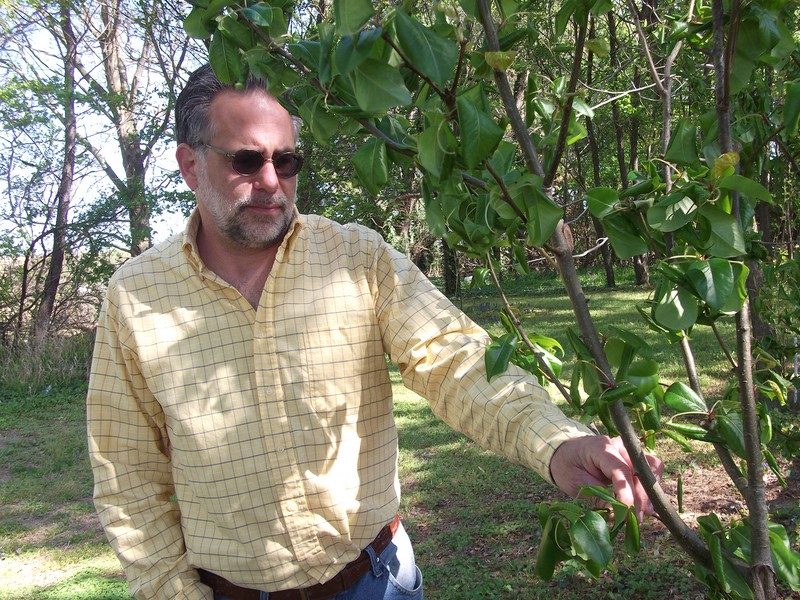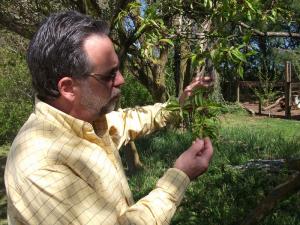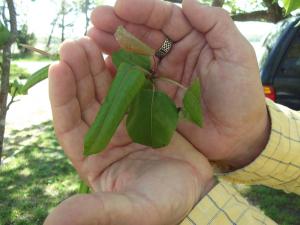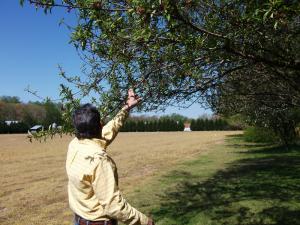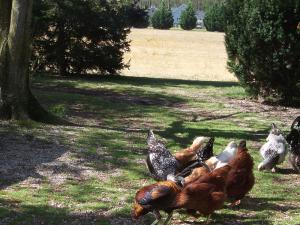Milton resident says stray spray stunted his trees
Bob Natrin moved to Milton from Wilmington to enjoy the open country and fresh air. That dream was sullied earlier this month when wind blew a growth-stunting herbicide sprayed on a neighboring farm field onto Natrin's property.
Natrin says the herbicide, similar to Roundup, withered his shrubs and plantings; he said he knows the plants will not produce fruit this year because it has happened before.
Four years ago, Natrin said Growmark FS of Milford sprayed the no-till soybean field next to Natrin's house. The wind carried the herbicide mix onto Natrin's 1.6-acre property, stunting 20 fruit trees, which produced no fruit that year.
Natrin said the herbicide stops cellular reproduction, so the fruit trees, some with buds and blossoms still on them, will not grow anymore this year. They will not produce fruit, and Natrin will lose another summer's bounty.
“I was working outside and saw the sprayer going down the field next door,” Natrin said. “"I felt the wind blowing directly into my face so I went into my house so I wouldn't have to breathe the chemicals. I knew it was happening again."
After the Growmark contractor finished spraying, Natrin began investigating his trees and found the same withered look he saw in 2009.
"It's just heartbreaking to think this is happening again," Natrin said.
Growmark FS President Steve Buckalew said he had heard about Natrin's situation both times the spray drifted, but Buckalew has not spoken to Natrin personally.
Buckalew said incidents of stray spray harming another property are infrequent, with fewer than six drifts reported each year.
He said the state will investigate to determine if the Growmark sprayer is responsible.
"Our position is it was done under ideal conditions," Buckalew said. "There are times when these things happen, and if there is damage, we offer compensation to make it good. It can be monetary."
Buckalew said the season just started, and most no-till fields are being sprayed now. He said the extent of damage cannot be known until months from now when a crop is harvested.
Agriculture Secretary Ed Kee said the state gets five to 10 complaints about spray drift per year. He said the state's pesticide compliance section sends an investigator to assess damage to a property.
"We look at it, determine what happened, and then it is really up to the two parties – the homeowner and the spray company – to determine compensation," Kee said. "We don't get involved in the compensation."
David Pyne, Delaware Department of Agriculture pesticide compliance administrator, visited Natrin's property with Jimmy Hughes, a state pesticide investigator, to take pictures April 30. The pair returned to the home May 1 and collected two pounds of plant samples.
Pyne said the samples have been sent to an out-of-state lab for analysis. He expects to have results in 30 days.
Pyne said while the Department of Agriculture does not determine compensation, a state hearing could be held and a penalty could be issued to Growmark if the company's sprayer was negligent.
"Once the investigation is completed, it is given to me and I review the case and determine if negligence was involved," Pyne said. "Then I give it to the deputy attorney general's office and they can schedule a hearing. The hearing officer makes the final decision and a penalty can be given at that time."
Penalties for negligent spraying can cost companies up to $2,500. In some cases, Pyne said part of the penalty can be given to the homeowner.
Pyne said he can't comment on the investigation and will wait for the samples to be analyzed before he makes a decision.
Kee said investigators decide if the chemicals were sprayed according to the product's label directions by looking at damage to the trees, talking to the sprayer and homeowner and reviewing weather conditions for the day the spraying occurred.
"This is the tension out there because of farming on the suburban fringe," Kee said. "Usually it is worked out, and rarely does it go to court."
Larry Lee, operations manager for Growmark, said he spoke to Natrin about the problem.
"We were reluctant to contract with the farmer to spray that field again this year," after the previous harm to Natrin's property, Lee said.
"We use all the precautions that we can to make sure there is no drift," such as driving the sprayer slowly and making sure the wind isn't blowing toward a neighboring property.
Lee said the damage could also be weather-related.
"Everything gets tricked into thinking summer is here; then you get some cold mornings," Lee said.
Lee said Growmark sprays thousands of acres in Delaware for weeds and insects, and millions total in the surrounding six states that the company serves. The company also contracts with farmers to apply fertilizer.
He said he regrets the problems Natrin is having, but he has to wait until the investigation is complete to determine if Growmark was at fault.
If the state finds negligence, Lee said Growmark will do what it can to make it right.
"We try to be good stewards in the community. Hopefully it is not something we did negligently," Lee said.
Natrin said the last time his property was harmed, Lee offered him a bushel of peaches in return.
He said this year he will seek compensation from Growmark and take his complaint as far as he needs to – including to court – for reimbursement.
“Growmark made $10 billion last year and have insurance and deep pockets for this type of damage, but three years ago they stonewalled me, the little guy, until I gave up. Not this year,” Natrin said.
Water quality worries
Natrin is also worried about water quality, although he said it is not necessarily related to herbicide use.
The U.S. Environmental Protection Agency sets regulations on nitrates. The EPA found 10 parts per million to be an acceptable level to protect human health.
When he moved in, the nitrates in his well were acceptable, at 9 parts per million. When Natrin's property was first accidentally sprayed in 2009, tests for nitrates showed 16 parts per million.
Natrin immediately switched to drinking bottled water for himself and his family.
"I came to live in the country thinking it was fresh and clean, now I find out we are living and bathing in a pool of chemicals," Natrin said.
According to the EPA Region 3 office in Philadelphia, nitrates enter drinking water through runoff from fertilizer use, leaking from septic tanks and erosion of natural deposits.
Kee said nitrogen levels in water are not related to land application of spray herbicide because these sprays do not contain nitrogen.
The chemical make-up of the spray used by Growmark includes Envive herbicide made by DuPont; Glyfos® X-TRA Herbicide made by Cheminova; Prowl H20 Herbicide made by BASF Corp. for use in biofuel crops; and Radar LV, an herbicide made by Growmark Inc. The mixtures also included ammonium sulfate to enhance performance.
Kee said water pollution, specifically nitrates, can be caused by lawn fertilizer, farm fertilizer, poultry manure or atmospheric deposition.
Alan Pongratz, supervisor of the water supply section at the Delaware Department of Natural Resources and Environmental Control said in order to permit a well, the water must meet EPA standards.
Pongratz said in cases where the water does not meet standards, homeowners have several options – drilling a deeper well, installing a reverse osmosis treatment unit to one faucet or putting in a whole-house water treatment system.
"It is up to the homeowner to have his well tested," Pongratz said. "Depending on the season, the chemical make-up can change."
Pongratz said higher levels of nitrates are common in Sussex County because it is an agricultural area. He said most deeper wells have not been affected by nitrates because they are protected by a layer of clay between the shallow aquifer and a deeper one.
"The well has been here as long as the house has," Natrin said. "I have not considered drilling another well."
He said he expects Artesian Water will connect houses on Shingle Point Road, including Natrin's home, to Milton's public water system in the future. Until then, he plans to drink bottled water.
Shane Abbott of Sussex County Planning & Zoning said if a parcel for a new home is adjacent to an agricultural use, an agricultural-use protection notice is included in the settlement documents, informing the homeowner that agricultural uses will take place near the new home. Sussex County Council passed the law in 1993 to require the notice be included for all new parcels and developments.
When a person buys an existing house near an agricultural use, a notice is not required, Abbott said.














